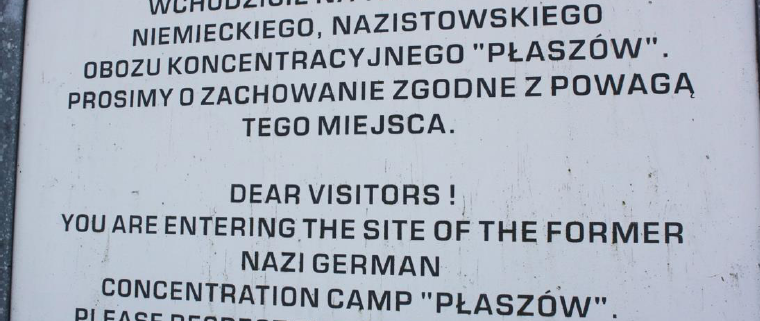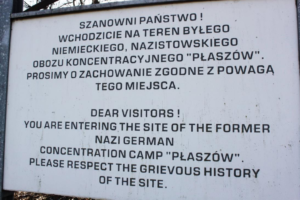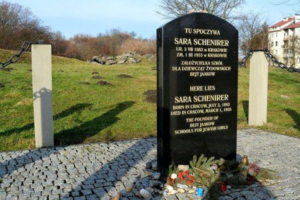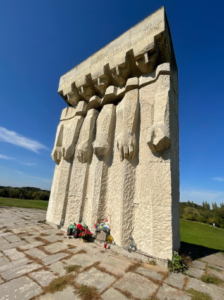Płaszów: A Recreational Park Built on a Concentration Camp
By Capriana Cormier
KL Płaszów was a Nazi concentration camp in Płaszów, a southern district in Kraków, during the Second World War. This camp was built on two Jewish cemeteries. It was opened, by the Nazis, from late 1942 until early 1945, and was intended to hold about 4,000 prisoners in, what was supposed to be a slave labor camp, as an attempt to clear out of Kraków ghetto. It is unknown how many prisoners were at Płaszów because no documents survived, it is known however that at the camp’s peak time there was anywhere between 20,000 – 25,000 prisoners at once. Although most of the prisoners in this camp were from the Kraków Region, there were also prisoners brought in from the Lublin and Radom districts, and ghettos in Poland, as well as hundreds of Romani. The camp was also used as a transit camp for the Jews who were being transported to Auschwitz from Hungary and Slovakia, and hundreds of Roma. (Krakow Museum). The first deportation started with the liquidation of the Kraków ghetto, 8,000 Jews from the ghetto were brought to Płaszów. There the prisoners were under the watch of Amon Göth, a brutal SS officer.
Amon Göth was the commandant of this camp, he made sure that Płaszów was hell for the prisoners that were there. Göth was known for “collective punishment and wouldn’t hesitate to execute or severely beat prisoners” (History UK). Göth also made the other prisoners, even children, watch these punishments happen. He was a sadistic officer, and left survivors of the camps traumatized with his brutal actions. Written from an interview done by History UK, Helen Jonas-Rosenzweig, a survivor of the prison who was Göth’s maid, said “As a survivor I can tell you that we are all traumatized people, never would I, never, believe that any human being would be capable of such horror, of such atrocities.”
Present day, the camp is destroyed. The entire campgrounds are not accessible either, a part of the area was built over. When you enter the camp grounds there is an information plaque that tells what the camp is and tells you to “respect the grievous history of the site.” When you walk through the camp you can find a headstone made in honor of Sara Scheinrer, a woman who was the founder of the Beit Jaakow Schools for Jewish Girls. And a few other memorials as well, one for the Jewish victims of the camp, a cross on the hill in the camp where executions took place on a daily basis. And finally, an abstract memorial made of stone, of 5 people looking down dedicated to the entire camp. This is the largest memorial on the camp, the shoulders and heads are split from the rest of their bodies. The back of the memorial reads (in Polish) “In tribute to the martyrs murdered by the Nazi genocides in the years of 1943-1945.” While you walk through the site you also can read informational plaques about some of the things that happened at the camp. The sign that stuck out most to me described one of the many terrible things Amon Göth did. The camp is mostly well known for its significance in the Steven Spielberg’s movie Schindler’s List.
Something that I did notice while I was at the camp site was that this place is also used as a recreational park. There were adults and children hiking and riding their bicycles as well as using the camp as a running trail. At the end of the camp, but still in the area of the former camp grounds, modern housing apartment blocks have been built, as well as a McDonalds, and a 24-hour liquor store. It is unsettling that such developments happened on a mass murder site. So, the question comes up, how should people commemorate this camp site and why commemoration should be happening at Płaszów. While for some the development of this site might signal a moving on from the tragedy of World War II. However, others can see this as disrespectful. There are informational plaques spread throughout the site, 19 in total, with photos and information of what happened in that space. There is talk of building a permanent exhibition on the camp, but nothing is set in stone yet.
Is it acceptable for people to be using this site as a recreational park? Personally, I believe that is taking away from the importance of the commemoration. I think it is inappropriate to use a place where such brutal things happened to prisoners, where people died every day, as a place to take your kids bike riding, or to use it as a personal walking track. There is nothing I can say about the buildings built on the camp site grounds, other than those people who live there should be educated about what land they are living on, to be respectful, and understand that people may be angry about where they live. But having a McDonald’s built on the camp site and a 24-hour liquor store as you “leave” the camp site is not a way to show your commemoration or your respectful moving on from the past.
So how can, and how should, people commemorate Płaszów now? First the grounds should be honored as any other existing concentration camp site. People would not go to Auschwitz to ride their bikes or hike a trail. There should be no difference with this camp. However, because it is already used as a recreational park, the least one can do is educate themselves on what happened there, understand that it is a place where many people died. Sylwia Porąbka suggests possibly fencing in the former camp site might help to keep people from going there to use it for their own purposes, or permitting only certain activities to happen in certain areas (Politeja).
Everyone has their own way of remembering history, whether they choose to forget it, remember it, or bring attention to the tragic history of what happened. No matter how you choose to remember history, it should be remembered in a respectful way. When you know you are in a place where so much history has happened, try to educate yourself to the best of your abilities. Understand that there was a tragic past and be as respectful as possible. At a place like Płaszów where people use the space as a recreational park now, the very least that can be done is becoming educated on the tragic past.
Sources
- https://muzeumkrakowa.pl/en/news/history-of-german-nazi-concentration-camp-in-krakow-plaszow
- https://encyclopedia.ushmm.org/content/en/article/plaszow
- https://www.history.co.uk/article/the-horrors-of-the-krak%25C3%25B3w-p%25C5%2582asz%25C3%25B3w-concentration-camp
- https://www.britannica.com/place/Plaszow
- https://journals.akademicka.pl/politeja/article/view/1502





